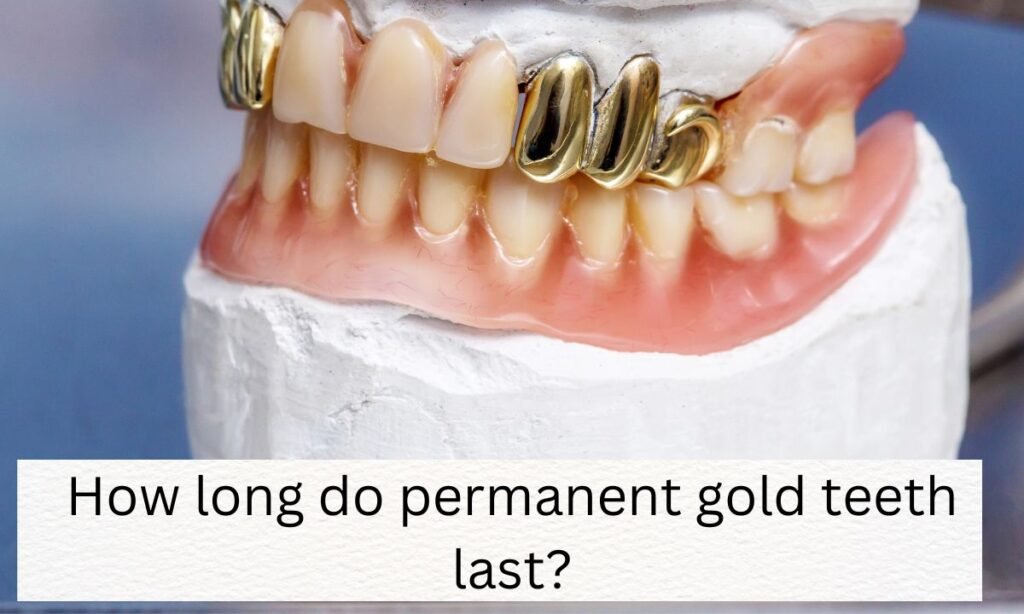When considering dental restorations, one common question is, “How long do permanent gold teeth last?”
If you’re exploring gold as a durable option for dental work, this guide will provide you with detailed insights into their lifespan, advantages, disadvantages, and care.
Understanding Permanent Gold Teeth

What Are Permanent Gold Teeth?
Permanent gold teeth are dental restorations made from gold alloys, which combine gold with other metals like platinum, copper, and silver. These alloys are specially formulated to enhance strength, durability, and biocompatibility. Gold teeth are designed to be a long-lasting solution for dental restoration needs.
Why Choose Gold?
Gold has been used in dentistry for centuries due to its superior properties. It is renowned for its:
- Durability: Gold can withstand significant chewing pressures and resist wear and tear.
- Biocompatibility: It is less likely to cause allergic reactions compared to other metals.
- Corrosion Resistance: Gold does not rust or corrode, ensuring longevity.
Longevity of Gold Teeth
How Long Do Gold Teeth Last?
Gold dental restorations are celebrated for their longevity. On average, they can last between 20 and 30 years.
With exceptional care, some gold restorations have been known to endure up to 40 years. This remarkable lifespan far exceeds many other dental materials and speaks to the overall permanent teeth durability in adults.
Factors Affecting the Lifespan of Gold Teeth
Several factors influence how long your gold teeth will last:
- Oral Hygiene: Consistent brushing and flossing are crucial. Gold restorations, while durable, need proper care to avoid plaque buildup around them, which can lead to decay in the underlying tooth.
- Diet: A diet high in sugar or acidic foods can impact the surrounding natural teeth, although gold itself is resistant to these effects. Avoiding hard or sticky foods also helps prevent damage.
- Bite Force: Heavy bite force or teeth grinding can affect the longevity of gold restorations. Using a night guard can protect against the damage caused by bruxism.
- Dental Care: Regular dental check-ups ensure that any issues are detected early and addressed promptly, extending the life of your gold restorations.
Comparison with Other Dental Materials
To understand the value of gold, it’s essential to compare it with other dental materials:
Looking at durability and lifespan, gold outlasts most common tooth replacement options, especially when compared with bridges or composite alternatives.
Gold vs. Porcelain and Ceramic
- Porcelain: Lasts 10 to 15 years. It can chip or crack, especially under heavy chewing pressures.
- Ceramic: Also lasts 10 to 15 years. Provides a natural look but may not be as durable as gold.
- Composite: Generally lasts 5 to 7 years. It is less durable and more prone to staining compared to gold.
Advantages of Gold Teeth
Why Opt for Gold?
- Durability and Longevity: Gold’s ability to withstand substantial chewing forces makes it ideal for back teeth where pressure is highest.
- Biocompatibility: It’s less likely to cause allergic reactions, making it a good choice for those with metal sensitivities.
- Strength and Resistance to Wear: Gold maintains its shape and functionality over time, reducing the likelihood of cracks or chips.
Disadvantages of Gold Teeth
What to Consider Before Choosing Gold
- Cost: Gold restorations are more expensive than alternatives like porcelain or composite. However, their durability may offset the higher initial cost.
- Appearance: Gold is often used for back teeth due to its color. It may not be suitable for those who prefer a more natural appearance for front teeth.
- Galvanic Action: When combined with other metals, gold can cause a metallic taste or mild discomfort due to galvanic action. Proper integration with existing dental work can minimize this effect.
Care and Maintenance
Keeping Your Gold Teeth in Top Shape
- Daily Oral Hygiene: Brush twice a day with fluoride toothpaste and use a soft-bristled toothbrush. Floss daily to remove plaque around the restoration. Consider using an antibacterial mouthwash for additional protection.
- Regular Dental Check-ups: Visit your dentist regularly for cleanings and examinations. Your dentist will monitor the condition of your gold restorations and make any necessary adjustments. This also ensures you’re keeping tabs on dental crown longevity if you have gold crowns in place.
- Avoiding Harmful Habits: Protect your gold restorations by avoiding hard objects and managing teeth grinding with a night guard if needed.
Signs of Wear and Tear
How to Identify and Address Issues
Look out for these signs:
- Visible Damage: Any noticeable cracks or chips in the gold restoration.
- Discomfort: Unexplained pain or sensitivity around the restoration.
- Fit Changes: Difficulty in chewing or changes in how the restoration fits.
When to Consult a Dentist
Contact your dentist if you notice:
- Persistent discomfort or pain.
- Visible damage to the restoration.
- Changes in chewing ability or fit.
Cost Considerations
Understanding the Financial Aspect
Gold restorations generally have a higher upfront cost compared to other materials. However, their longevity and durability can make them a cost-effective choice over time. Check with your dental insurance provider to see if they cover part of the cost for gold restorations.
FAQ
Conclusion
Permanent gold teeth offer exceptional durability and biocompatibility, making them a reliable choice for long-term dental health. With proper care and regular check-ups, they can provide decades of service. If you’re considering gold restorations, consult your dentist to determine if they’re the right choice for you.
Feel free to share this guide with others who may benefit from it. For personalized advice, always consult a dental professional to explore your best options for dental restorations.
Find Your Perfect Dentist
Book appointments with top-rated dentists in your area